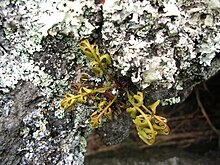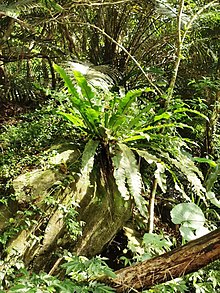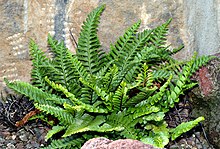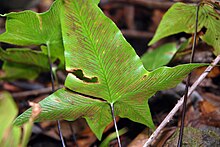Asplenium
| Asplenium | |
|---|---|

| |
| Maidenhair spleenwort (Asplenium trichomanesssp.quadrivalens) | |
| Scientific classification | |
| Kingdom: | Plantae |
| Clade: | Tracheophytes |
| Division: | Polypodiophyta |
| Class: | Polypodiopsida |
| Order: | Polypodiales |
| Suborder: | Aspleniineae |
| Family: | Aspleniaceae |
| Genus: | Asplenium L. |
| Type species | |
| Asplenium marinum | |
| Species | |
|
About 700, but see text. | |
| Synonyms | |
and see text | |
Aspleniumis agenusof about 700speciesofferns,often treated as the only genus in thefamilyAspleniaceae,though other authors considerHymenaspleniumseparate, based onmolecular phylogeneticanalysis ofDNA sequences,a different chromosome count, and structural differences in the rhizomes. Thetype speciesfor the genus isAsplenium marinum.
The most common vernacular name isspleenworts,applied to the more "typical" species.A. nidusand several similar species are calledbird's-nest ferns,theCamptosorusgroup is known aswalking ferns,and distinct names are applied to some other particularly well-known species.
Taxonomy and genetics
[edit]Many groups of species have been separated fromAspleniumassegregategenera. These includeCamptosorus,Ceterach,Phyllitis,andTarachia,but these species can formhybridswith otherAspleniumspecies and because of this are usually included in a more broadly definedAsplenium.[1]
Some of the older classifications elevate the Aspleniaceae to thetaxonomic rankoforderas Aspleniales. The newer classifications place it in the subordinal group called eupolypods within the orderPolypodiales.Within the eupolypods, Aspleniaceae belongs to acladeinformally and provisionally known as eupolypods II.
It has been found that in some species, thechloroplastgenomehasevolvedin complex and highly unusual ways. This makes standardcladisticanalyses unsuited to resolve thephylogenyof that particular group of ferns, and even very sophisticatedcomputational phylogeneticsmethods yield little information. In addition to hybridization running rampant in parts of this genus, there are also some species like themother spleenwort(A. bulbiferum) orA. viviparumwhich mainlyreproduce asexually,essentiallycloningthemselves over and over again. While most arediploidortetraploid,some species (e.g.A. shuttleworthianum) are octoploid.[2]
Uses
[edit]Both the scientific name and the common name "spleenwort" are derived from an old belief, based on thedoctrine of signatures,that the fern was useful for ailments of thespleen,[3]due to the spleen-shapedsorion the backs of thefronds."-wort" is an ancient English term that simply means "plant"(compareGerman-wurz). The plants were thought to causeinfertilityin women.[3]
Vitruviusrelates the story of the name thus:
... certain pastures in Crete, on each side of the river Pothereus, which separates the two Cretan states of Gnosus and Gortyna. There are cattle at pasture on the right and left banks of that river, but while the cattle that feed near Gnosus have the usual spleen, those on the other side near Gortyna have no perceptible spleen. On investigating the subject, physicians discovered on this side a kind of herb which the cattle chew and thus make their spleen small. The herb is therefore gathered and used as a medicine for the cure of splenetic people. The Cretans call it ἄσπληνον. .Ten Books on Architecture– viaWikisource.
A few of these ferns have some economic importance in thehorticulturetrade. Thebird's-nest ferns(A. nidusand several very similar, closely related species) are commonly found for sale as ahouse plant.The Australianmother spleenwort(A. bulbiferum) is sometimes available atgreenhouses,and is of interest, along with the relatedA. viviparum,for the many small bulblets borne on the fronds that may grow into new plants. This characteristic is also shared with the eastern North Americanwalking fern(A. rhizophyllum) and several Mexican species includingA. palmeri.Theebony spleenwortA. platyneuronis also sometimes sold in nurseries as a hardy plant. However, many spleenworts are epipetric orepiphyticand difficult to cultivate.
Aspleniumspecies are used as food plants by thelarvaeof someLepidopteraspecies includingBatrachedra bedelliellawhich feeds exclusively onA. nidus.For diseases ofAsplenium,seeList of foliage plant diseases (Polypodiaceae).
Selected species
[edit]








- Asplenium adiantum-nigrumL.–black spleenwort(=A. lucidumBurm.f.)
- Asplenium adiantum-nigrumssp.adiantum-nigrum
- Asplenium adiantum-nigrumssp.serpentini(Tausch) Koch
- Asplenium adulterinumMilde–ladder spleenwort
- Asplenium aequibasis(C.Chr.) J.P.Roux
- Asplenium aethiopicum(Burm.f.) Bech.
- Asplenium africanum
- Asplenium × alternifoliumWulf.
- Asplenium anceps[Lowe ex Hook. et Grev. Page (1971)]
- Asplenium angustumSw.
- Asplenium antiquumMakino
- Asplenium arcanumA.R.Sm.
- Asplenium ascensionisS.Watson
- Asplenium attenuatumSw.
- Asplenium aureum(sometimes inCeterach)
- Asplenium auritumR.Br.
- Asplenium australasicum(J.Sm.) Hook.–crow's-nest fern
- Asplenium australasicumf.australasicum
- Asplenium australasicumf.robinsonii
- Asplenium azoricumLovis, Rasbach & Reichst.
- Asplenium bifronsSodiro
- Asplenium billottii–lanceolate spleenwort
- Asplenium bipinnatifidum
- Asplenium brachycarpum
- Asplenium bradleyi
- Asplenium bulbiferum–mother spleenwort,hen and chickens fern,mouku(Māori)
- Asplenium carnarvonense-Brownsey
- Asplenium caudatum
- Asplenium ceterach–rustyback fern(sometimes inCeterach)
- Asplenium chathamenseBrownsey
- Asplenium chihuahuenseBaker
- Asplenium compressumSw.
- Asplenium congestumC.Chr.
- Asplenium corderoanum
- Asplenium crinicaule
- Asplenium cristatum
- Asplenium cuneifoliumViv.(=A. forsteriauct. nonSadl.) –serpentine spleenwort
- Asplenium cymbifolium
- Asplenium daghestanicumH.Christ– Dagestanian spleenwort
- Asplenium dalhousiae(sometimes inCeterach)
- Asplenium dareoides
- Asplenium daucifoliumLam.–Mauritius spleenwort
- Asplenium difformeR.Br.
- Asplenium fissum
- Asplenium dimorphumKunze–Norfolk Island Spleenwort
- Asplenium divaricatum
- Asplenium dregeanum
- Asplenium × ebenoidesR.R.Scott
- Asplenium ecuadorenseStolze
- Asplenium feeiKunze ex Fée
- Asplenium fissum
- Asplenium flabellifoliumCav.–necklace fern
- Asplenium flaccidumG.Forst.–weeping spleenwort,hanging spleenwort
- Asplenium fontanum(L.) Bernh.–smooth rock spleenwort
- Asplenium forisiense–rock spleenwort
- Asplenium formosum
- Asplenium gemmiferumSchrad.
- Asplenium × germanicum
- Asplenium gueinziiMett.
- Asplenium goudeyiLord Howe Island
- Asplenium haughtonii– Barn Fern
- Asplenium hemionitis
- Asplenium hermannii-christiiFomin– Hermann Christ's asplenium
- Asplenium hookerianumColenso
- Asplenium hybridum
- Asplenium incisum
- Asplenium × jacksoniiAlston– Jackson's spleenwort (sterile, triploid hybrid betweenAsplenium adiantum-nigrumandAsplenium scolopendrium)[4]
- Asplenium × kenzoi- oni-hinokishida,[5]cultivated in Japan[6]
- Asplenium komarovii-Akasawa[7]
- Asplenium laciniatum
- Asplenium lamprophyllumCarse
- Asplenium laserpitiifolium–Johnston River fern
- Asplenium lepidumC.Presl
- Asplenium listeri–Christmas Island spleenwort
- Asplenium longissimum
- Asplenium lucidum
- Asplenium lunulatum–Hen-and-chicks
- Asplenium lyallii
- Asplenium macedonicum[8]
- Asplenium majoricum
- Asplenium marinum– sea spleenwort
- Asplenium × microdonT Moore– Moore's spleenwort (hybrid betweenAsplenium scolopendriumandAsplenium obovatumsubsplanceolatum)
- Asplenium milneiCarruth
- Asplenium montanum–mountain spleenwort
- Asplenium musifolium
- Asplenium nidus– bird's-nest fern
- Asplenium normale
- Asplenium obliquum
- Asplenium oblongifoliumColenso–shining spleenwort(=A. lucidumauct. nonBurm.f.,sensuG.Forst.)
- Asplenium obovatum
- Asplenium obtusatumG.Forst.
- Asplenium obtusatumssp.northlandicum(Brownsey) Ogle(possibly distinct species)
- Asplenium obtusatum'Chile' (possibly distinct species, sometimes included inA. obliquum)
- Asplenium oligolepidumC.Chr.(=A. lucidumauct. nonBurm.f.,sensuG.Forst.)
- Asplenium oligophlebium
- Asplenium onopterisL.–western black spleenwort,Irish spleenwort(sometimes included inA. adiantum-nigrum)
- Asplenium pacificum
- Asplenium paleaceumR.Br.–chaffy spleenwort
- Asplenium palmeri
- Asplenium parvum
- Asplenium petrarchae
- Asplenium pinnatifidum–lobed spleenwort
- Asplenium planicaule
- Asplenium platybasisKunze ex Mett.
- Asplenium platyneuron–ebony spleenwort
- Asplenium polyodonG.Forst.–sickle spleenwort
- Asplenium praemorsum
- Asplenium prolongatumHook.
- Asplenium pteridoidesBaker
- Asplenium resiliens–black-stemmed spleenwort
- Asplenium rhizophyllum–American walking fern(sometimes inCamptosorus)
- Asplenium richardii
- Asplenium ruprechtii–Asian walking fern(sometimes inCamptosorus)
- Asplenium ruta-murariaL.–wall-rue
- Asplenium rutifolium
- Asplenium sagittatum–Mule's spleenwort(sometimes inPhyllitis)
- Asplenium sandersoniiHook.
- Asplenium × sarnienseSleepGuernsey Spleenwort
- Asplenium schizotrichumCopel.
- Asplenium schweinfurthii
- Asplenium scleroprium
- Asplenium scolopendrium–hart's-tongue fern(sometimes inPhyllitis)
- Asplenium scolopendriumvar.americanum– American Hart's-tongue
- Asplenium seelosii
- Asplenium septentrionale–forked spleenwort,northern spleenwort
- Asplenium septentrionale × trichomanesWulf.
- Asplenium serra
- Asplenium serratum–wild bird's-nest fern
- Asplenium sessilifolium
- Asplenium shuttleworthianumKunze
- Asplenium simplicifronsF.Muell.
- Asplenium splendens
- Asplenium surrogatumP.S.Green
- Asplenium tenerumG.Forst.
- Asplenium terrestre
- Asplenium theciferum(Kunth) Mett.
- Asplenium thunbergii
- Asplenium trichomanes–maidenhair spleenwort
- Asplenium trichomanesssp.quadrivalensD.E. Meyer
- Asplenium trichomanesssp.trichomanes
- Asplenium trichomanessubsp.coriaceifolium
- Asplenium trilobumCav.
- Asplenium tutwileraeB.R.Keener & L.J.Davenport
- Asplenium vespertinum
- Asplenium vieillardiiMett.
- Asplenium virens
- Asplenium viride–green spleenwort
- Asplenium vittiforme
- Asplenium viviparum
See also
[edit]- Mount Asplenium
- Phyllocladus aspleniifolius(Celery-top Pine, aconiferwithAsplenium-like leaves)
- Aspleniumhybrids
References
[edit]Asplenium.
- ^Schneider, Harald; Russell, Steve J.; Cox, Cymon J.; Bakker, Freek; Henderson, Sally; Rumsey, Fred; Barrett, John; Gibby, Mary;Vogel, Johannes C.(2004). "Chloroplast Phylogeny of Asplenioid Ferns based on rbcL and trnL-F Spacer Sequences (Polypodiidae, Aspleniaceae) and its Implications for Biogeography".Systematic Botany.29(2): 260–274.doi:10.1600/036364404774195476.S2CID85868809.
- ^Lara D. Shepherd, Barbara R. Holland & Leon R. Perrie (2008). "Conflict amongst chloroplast DNA sequences obscures the phylogeny of a group ofAspleniumferns ".Molecular Phylogenetics and Evolution.48(1): 176–187.Bibcode:2008MolPE..48..176S.doi:10.1016/j.ympev.2008.02.023.PMID18462954.
- ^abBill Neal (1992).Gardener's Latin.London:Robert Hale.p. 12.ISBN0709051069.
- ^Murphy, Rosaline J; Page, Cristopher N; Parslow, Rosemary E; Bennallick, Ian J (2012).Ferns, Clubmosses, Quillworts and Horsetails of Cornwall and the Isles of Scilly.Truro: ERCCIS.ISBN978-1-902864-07-5.
- ^"Asplenium×kenzoi".Germplasm Resources Information Network.Agricultural Research Service,United States Department of Agriculture.RetrievedDecember 15,2017.
- ^N. Murakami; S. Nogami; M. Watanabe; K. Iwatsuki (1999)."Phylogeny of Aspleniaceae inferred from rbcL nucleotide sequences".American Fern Journal.89(4): 232–243.doi:10.2307/1547233.JSTOR1547233.
- ^"Asplenium komarovii Akasawa | Plants of the World Online | Kew Science".
- ^"The list of plant and animal species for which the status of natural rarities was established".Archived fromthe originalon August 7, 2011.RetrievedAugust 26,2010.
